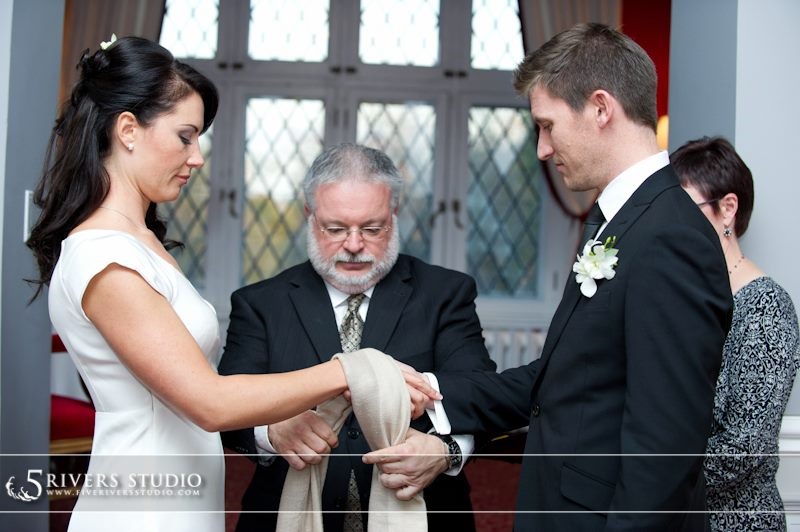Chapel Offers Handfasting!

January 6, 2017
Handfasting is the process of wrapping cords or ribbons around the wedding couple’s clasped hands and knotting them, symbolically binding their lives together. It has been popular over the last several decades with Wiccan and Pagan religions, but can now be found as a part of non-denominational or other religions’ wedding ceremonies as well. We’ve seen a few ceremonies at the Ottawa Wedding Chapel where the couple have included handfasting.
As far as historians can tell, handfasting dates back to ancient Celtic Scotland and was originally part of a formal betrothal ceremony (the precursor to today’s engagement). The couple pledged themselves to one another for future marriage. It seems likely that the term “handfast” was taken from the Old Norse “handfesta” meaning to strike a bargain by joining hands. It follows the same logic as our common handshake to seal a deal. Handfasting is also probably where the phrase “tying the knot” came from.
Modern-day Pagans and Wiccans were the first to revive the use of handfasting. They use the power of intent as part of the ceremony. The tying of the couple’s hands is a visual illustration of their intent to be bound together. The cords or ribbons may be braided or woven together in advance while carefully thinking of good wishes for the couple.
A full Wiccan handfasting ceremony might involve several cords. A cord could be draped across the couple’s clasped hands for any or each of the following: sharing of pain, sharing of laughter, sharing of burdens, sharing of dreams, using anger to temper the union, and honouring each other. Once all the cords are laid, they are tied together.
Incorporating handfasting
While sometimes a couple will choose a full handfasting ceremony, more commonly it is incorporated into their vows. We have seen an officiant say something along the lines of, “Please join hands. As your hands are joined with this ribbon, so are your lives, holding each other, caressing each other, supporting each other and loving each other.” The couple’s hands remain tied as they say their vows to each other and then the ribbon is removed without untying the knot. Another option is to give each guest (or maybe just your witnesses or children) a ribbon and have them all bind your hands together.
A possible downside is that you may need a rehearsal, especially if you are using more than one ribbon or cord, just so there is no fumbling on the big day. A rehearsal may result in an extra payment to your officiant.
Handfasting can be a beautiful addition to your wedding ceremony. It’s a great way to work in personalized vows or wording. The tying of the cords or ribbons is an illustration of your intent to bind your lives together. It may be something that your guests haven’t seen before. If you’re interested in adding handfasting to your ceremony, we’re happy to accommodate you at the Ottawa Wedding Chapel.